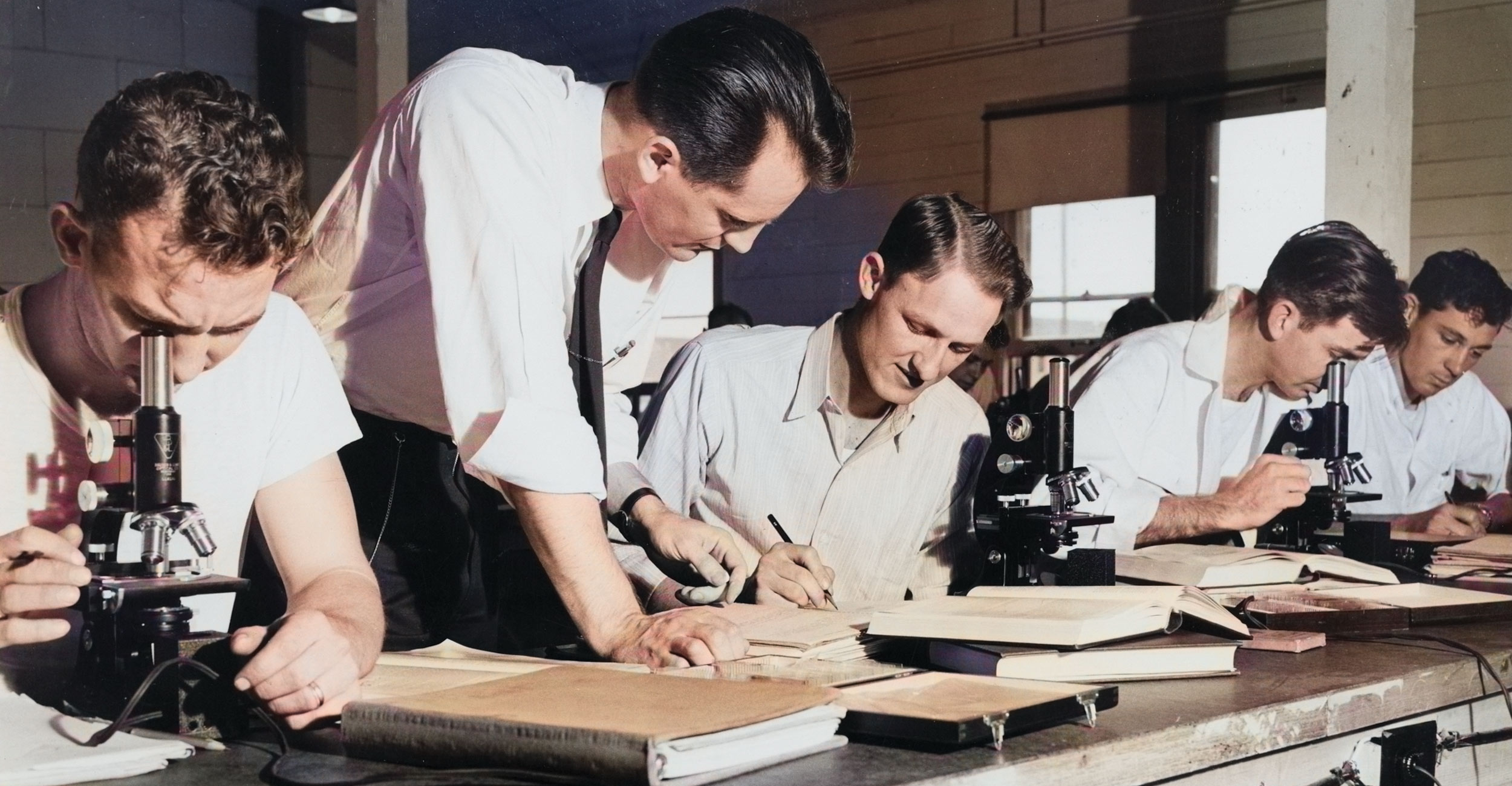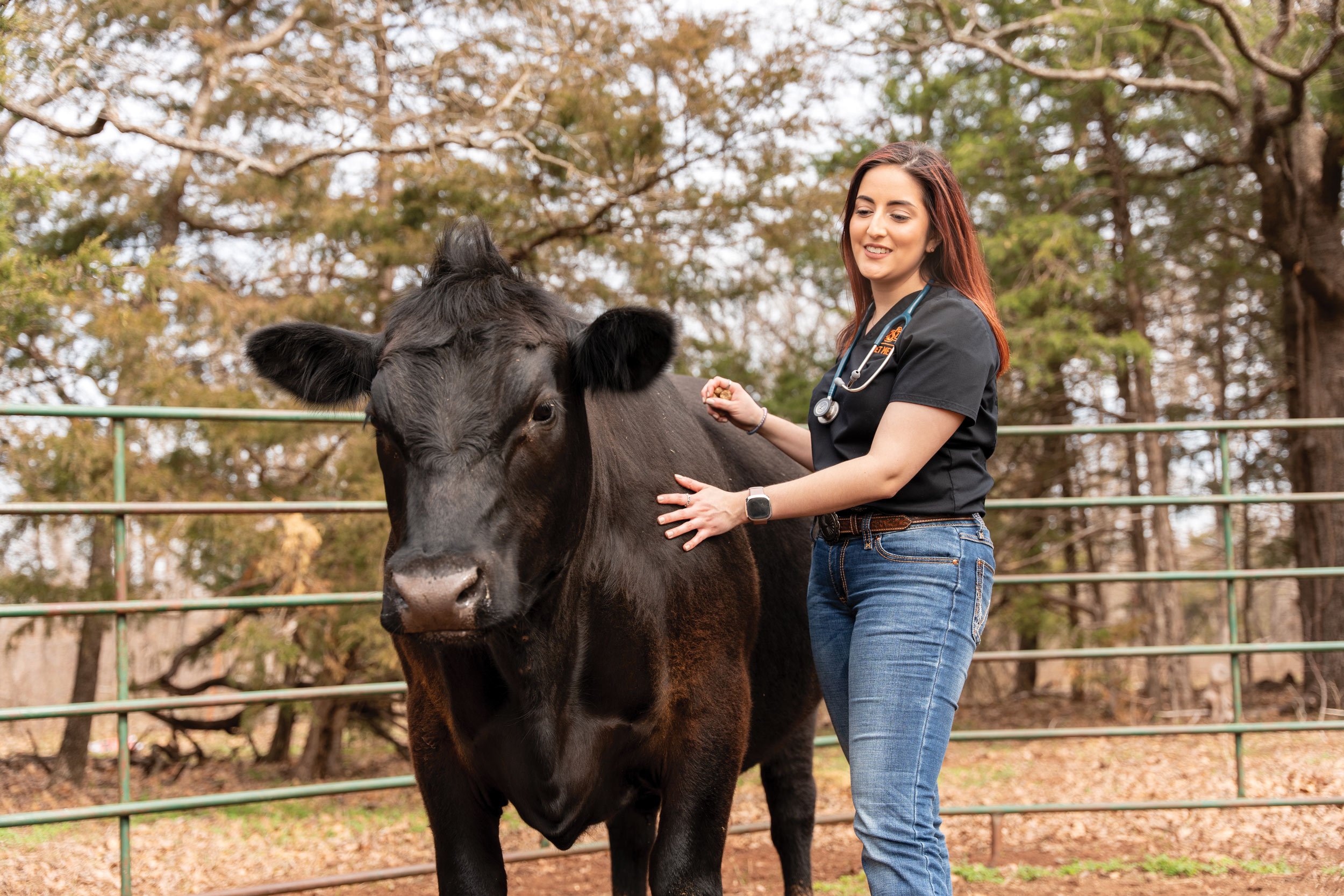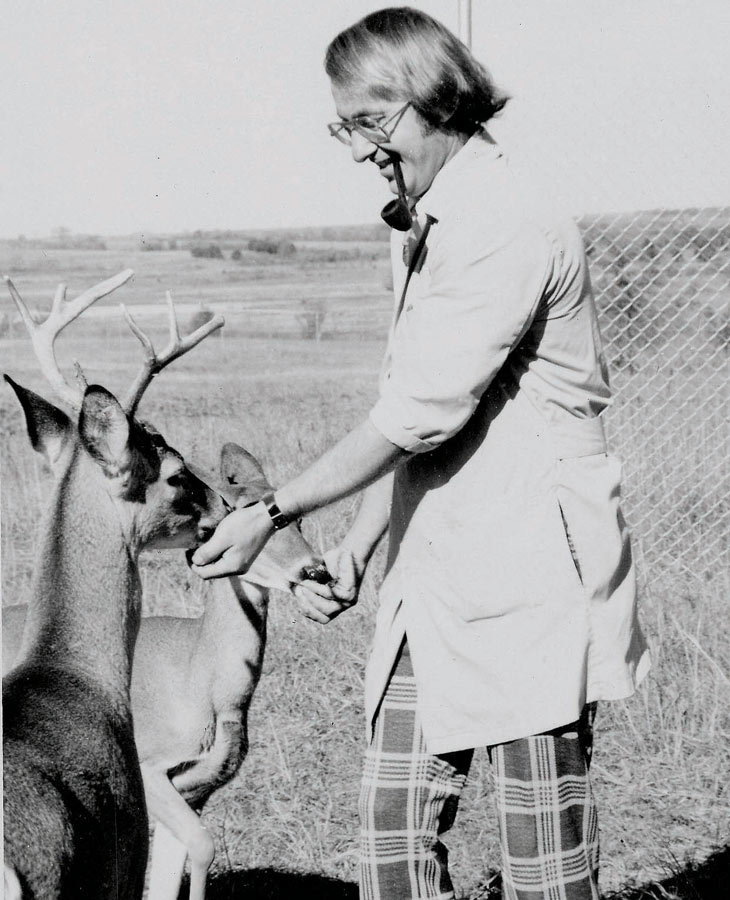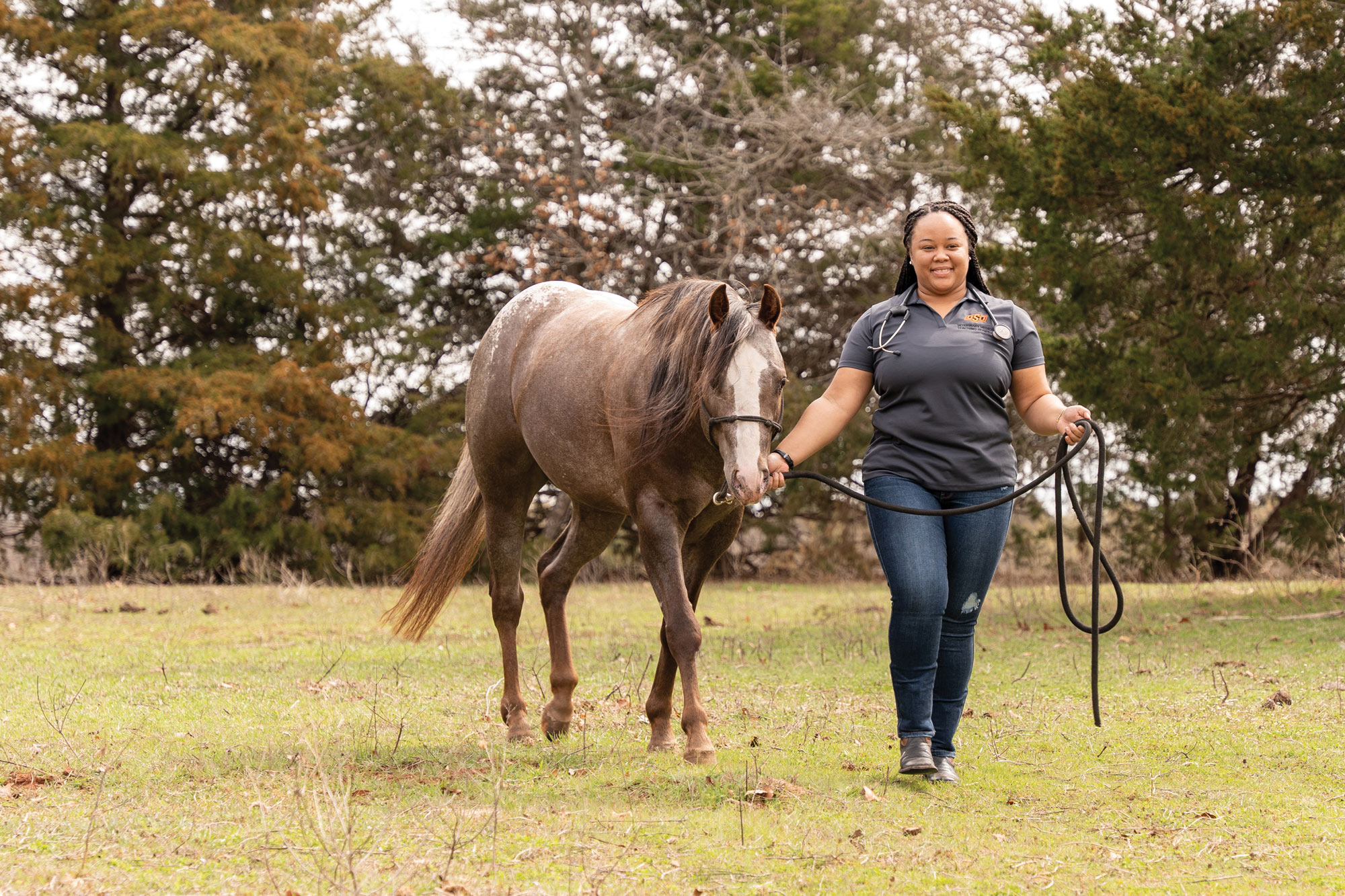
Sustained Value: OSU College of Veterinary Medicine commemorates three quarters of a century
Friday, January 19, 2024
Media Contact: Taylor Bacon | Public Relations and Marketing Coordinator | 405-744-6728 | taylor.bacon@okstate.edu
In May 2023, legislators in Oklahoma City emphasized the importance of veterinary medicine to the state of Oklahoma, echoing a similar sentiment almost eight decades before.
In May 1947, then Oklahoma A&M College President Henry G. Bennett remarked that a veterinary school “answers one of the foremost educational needs in the progressive post-war college program.”
Although the state wasn’t even 50 years old in 1947 and OAMC wouldn’t become Oklahoma State University until a decade later, Bennett’s remarks then hold the same weight today.
Oklahoma might look different than it did 75 years ago when America was coming off the heels of World War II and the Great Depression and Dust Bowl were still a recent memory for many, but what remains the same is the state’s reliance on animals.
It makes the need for healthy livestock and pets that much more crucial. Which is why a little over 75 years after the doors opened on the then-School of Veterinary Medicine on March 1, 1948, Oklahoma legislators continued their support for the state’s lone veterinary college — one of just 33 nationwide — with the passage of House Bill 2863. The bill established the Oklahoma State University Veterinary Medicine Authority.
“Oklahoma State University has long been a leader in animal health in Oklahoma,” said Rep. Kevin Wallace, a co-author of the bill with Sen. Chris Kidd. “This bill will provide the college with the support it needs to educate a critical veterinary workforce and build a solid and long-lasting future for the College of Veterinary Medicine.
“Families and the state’s agricultural producers will benefit as more highly qualified veterinarians graduate from the program, bringing their expertise and in-demand skills to communities across the state.”
Humble Beginnings
When Bennett announced the opening of the College of Veterinary Medicine 75 years ago, it gave credence to a program that had been working behind the scenes for almost 30 years prior.
OSU’s veterinary program began in 1913, a little more than two decades after the university’s founding in 1890. Yet, because of a lack of funding and low turnout from students, the program struggled for years until leadership like Bennett began to see the importance of having a well-funded veterinary school.

In the first book of OSU’s Centennial Histories Series, “A History of the OSU College of Veterinary Medicine,” Eric Williams said a study of a veterinary school’s worth to the state in 1946 would be inestimable as the death losses of cattle, sheep and swine alone was more than $5.5 million.
That worth is still invaluable today to the state’s success.
“I cannot overstate the importance of the College of Veterinary Medicine to our state’s agriculture industry,” Oklahoma Secretary of Agriculture Blayne Arthur said. “For years, the CVM’s educational work and innovative research has resulted in Oklahoma becoming one of the top states for animal health and medicine.”
After Dr. Duane Peterson taught the first class in 1948, McElroy Hall was built the following year to be the home for the CVM. Student classes started out small with 26 in the first graduating class, and as a product of the time, were all men. The first female OSU veterinary student wouldn’t come until a few years later with Dr. June Iben.
Today’s classes now hover around the century mark with women making up the majority.
With the growth of the school and the influx of more students, the work of those veterinarians began to make news around the state and region, quickly making veterinarians looking for employment choose OSU.
“Not only did the program help provide a new generation of veterinary medical scientists, but its very existence also helped attract faculty and enhanced the scholarly atmosphere in which students wishing to become veterinarians were taught,” Williams wrote in his book.
The CVM’s research program opened in 1953 with the Veterinary Research Institute with the Comparative Biomedical Sciences Graduate Program opening around the same time.
Almost 30 years after the CVM officially opened its doors, the Oklahoma Animal Disease Diagnostic Laboratory became the CVM’s arm to serve producers and animal owners around the state, which it has been doing since 1975.
The CVM’s newest building, the Roger J. Panciera Education Center, named after the prominent CVM alumnus and faculty member, opened in 2021, showing the school’s dedication to remain at the forefront of veterinarymedicine, something that seemed unattainable in 1913.
Research Rules
OSU CVM couldn’t have made the same impact if it weren’t for its researchers.
Yes, it’s common to see graduates in veterinary clinics throughout the state in rural and urban areas, its hospital — opened in 1981 — aids clients in real time, but its researchers help those beyond the region and even internationally.
In 1965, the first successful vaccine against anaplasmosis in cattle became available because of research led by Drs. William Brock and Charles Pearson along with Olin Kliewer at the CVM station in Pawhuska, Oklahoma.
A few years later in 1968, Dr. Leroy Coggins, a 1957 CVM alumnus, developed his eponymous test, which became the USDA official test for equine infectious anemia. The Coggins test is vital to the horse industry. Most carriers of EIA are asymptomatic, so testing helps identify carriers and prevent transmission. A negative Coggins test is required every time a horse is traveling, competing in a show or race, or any time a horse is purchased or sold.

Dr. Anthony Confer, class of 1972, worked to advance Bovine Respiratory Diseases research.
At the turn of the millennium, Drs. Katherine Kocan and Ed Blouin developed a new vaccine for anaplasmosis and Petri, the first in-vitro fertilized calf at OSU, was born.
All of these advancements paved the way for current OSU researchers in their studies of cancer, COVID-19 and more.
“Nothing illustrated the need for an approach rooted in One Health more than the COVID-19 pandemic,” said OSU Center for Health Sciences President Johnny Stephens. “Now, more than ever, we need to secure a solid foundation for the OSU College of Veterinary Medicine to help ensure we educate the veterinarians and researchers of the future.”
Dr. Kayse Shrum, OSU’s 19th president, might not have a background in veterinary medicine, but as a doctor of osteopathic medicine, she understands the connection humans and animals have. This research, known as One Health, has become one of Shrum’s largest areas of emphasis in her We Are Land-Grant strategy, released in 2022.
Experts estimate up to 75% of new or emerging infectious diseases could come from animals. Given the increasing prevalence of zoonotic diseases, the continuation of groundbreaking research into One Health — particularly on diseases of economic importance in Oklahoma — is a key factor in securing better health outcomes for Oklahomans.
“Addressing challenges in the One Health arena is a focus of the university’s larger strategy,” Shrum said. “The College of Veterinary Medicine’s success is a priority as it contributes to furthering the One Health mission in Oklahoma.”
To aid in the One Health initiative, Dr. Ashish Ranjan, CVM professor, was the brainchild of the Institute for Translational and Emerging Research in Advanced Comparative Therapy. The institute leads the One Health mission of OSU by bringing together clinicians, scientists and researchers involved in fundamental discoveries, industry and foundations together as well as hosting an annual conference that discusses the latest advancements in the field.
Dr. Lee Denney, a 1978 CVM alumna who served as the speaker pro tempore in the Oklahoma House of Representatives, said the One Health initiative is vital to the state’s food animal economy.
“One of our largest industries is beef cattle. Of course, we have pigs, sheep, goats, all the food animals, and keeping vigilance with these animals on foreign animal diseases coming into the state and keeping our food supply healthy is paramount to the state, and the vet school does that with their research,” Denney said. “… Then, you have to go to the small animal side of where we are in our society today with our pets. Dogs and cats, fish, birds, small rodents have become part of our families and working with that population, not only from a public health perspective to keep those animals healthy, but also from just an animal perspective, is taking care of a member of someone’s family.”
Eye on the Future
Denney has seen the growth of the CVM over the past 50 years. She even witnessed the commemoration of Oklahoma Veterinary Medicine Week by Gov. David Boren in 1977.
So, when the Legislature announced the OSUVMA in May, it showed Denney the CVM is getting the funding it needs to continue its great work.
“I’m very excited about what the Legislature did for the vet school,” Denney said. “I think through the lean years, we just haven’t paid attention to what we should have as far as veterinary medicine and the plan that Dr. Shrum has for the vet school. It’s very fitting to be unveiling all these plans during our 75th anniversary.”
CVM Dean Carlos Risco said he is excited about the transformational impact the OSUVMA will have on the college.

“The OSUVMA will support the hiring of new clinical faculty and enhance student training and operation of the veterinary teaching hospital,” Dr. Risco said. “This authority will allow the college to expand its efforts in order to fulfill its mission of being innovators in veterinary medical education, animal and human health.”
One area OSU expanded in 2020 and will continue to grow is thanks to Dr. Rosslyn Biggs, a second-generation CVM graduate who is now director of continuing education. She established the Integrated Beef Cattle Program to aid Oklahoma’s second-largest industry and combat the rural veterinary shortage. Because many areas are without veterinary services for cattle, it reduces the chances for prosperity in the field. Biggs hopes the new program can help solve that issue.
“The interest in the program has been outstanding and feedback from participants has been overwhelmingly positive,” Biggs said. “We are starting to see the connections that practitioners and students are making and look forward to continued growth.
“The program will lead to greater retention of new graduates in beef cattle practice and sustainable veterinary practices that provide enhanced animal health and welfare. We hope to address shortages in food supply veterinarians for years to come.”
Ideas like the Integrated Beef Cattle Program are what makes the CVM so crucial to OSU’s land-grant mission as well as its staying power in the state. From the initial support up to the OSUVMA, along with every producer and client who uses the OSU veterinary hospital or sees their hometown veterinarian who is an OSU graduate, the CVM has proved its worth for 75 years and doesn’t look to stop anytime soon.
“The college is positioned to see great success in the future,” Risco said. “With the continued support of OSU administration, Oklahoma legislators and generous donors, the CVM will continue to grow, reaching new heights in teaching, research and Extension.”
Photos By: Taylor Bacon
Story By: Taylor Bacon | Vet Cetera Magazine
